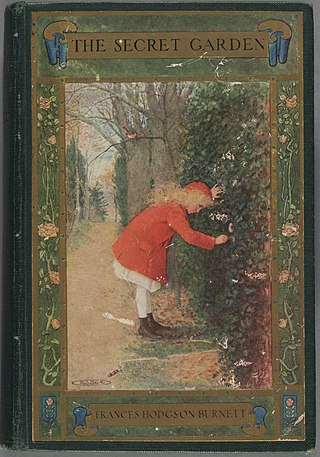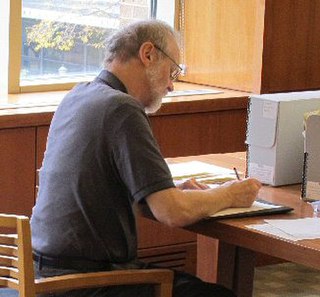
The Western canon is the body of high-culture literature, music, philosophy, and works of art that are highly valued in the West; works that have achieved the status of classics. However, not all these works originate in the Western world, and such works are also valued throughout the globe. It is "a certain Western intellectual tradition that goes from, say, Socrates to Wittgenstein in philosophy, and from Homer to James Joyce in literature".

The John Newbery Medal, frequently shortened to the Newbery, is a literary award given by the Association for Library Service to Children (ALSC), a division of the American Library Association (ALA), to the author of "the most distinguished contributions to American literature for children". The Newbery and the Caldecott Medal are considered the two most prestigious awards for children's literature in the United States. Books selected are widely carried by bookstores and libraries, the authors are interviewed on television, and master's theses and doctoral dissertations are written on them. Named for John Newbery, an 18th-century English publisher of juvenile books, the winner of the Newbery is selected at the ALA's Midwinter Conference by a fifteen-person committee. The Newbery was proposed by Frederic G. Melcher in 1921, making it the first children's book award in the world. The physical bronze medal was designed by Rene Paul Chambellan and is given to the winning author at the next ALA annual conference. Since its founding there have been several changes to the composition of the selection committee, while the physical medal remains the same.

The Secret Garden is a children’s novel by Frances Hodgson Burnett first published in book form in 1911, after serialisation in The American Magazine. Set in England, it is seen as a classic of English children's literature. The American edition was published by the Frederick A. Stokes Company with illustrations by Maria Louise Kirk and the British edition by Heinemann with illustrations by Charles Heath Robinson.
Elizabeth George Speare was an American writer of children's historical fiction, including two Newbery Medal winners, recognizing the year's "most distinguished contribution to American literature for children". In 1989 she received the Laura Ingalls Wilder Medal for her contributions to American children's literature and one of the Educational Paperback Association's top 100 authors.
The Association of Jewish Libraries (AJL) is an international organization dedicated to the production, collection, organization and dissemination of Judaic resources as a library, media, and information service. AJL has members in the United States, Canada, Israel and over 22 other countries.

The Mythopoeic Society (MythSoc) is a non-profit organization devoted to the study of mythopoeic literature, particularly the works of J. R. R. Tolkien, Charles Williams, and C. S. Lewis. These men were all members of The Inklings, an informal group of writers who met weekly in Lewis' rooms at Magdalen College, Oxford, from the early 1930s until late 1949.
The Science Fiction Research Association (SFRA), founded in 1970, is the oldest, non-profit professional organization committed to encouraging, facilitating, and rewarding the study of science fiction and fantasy literature, film, and other media. The organization’s international membership includes academically affiliated scholars, librarians, and archivists, as well as authors, editors, publishers, and readers. In addition to its facilitating the exchange of ideas within a network of science fiction and fantasy experts, SFRA holds an annual conference for the critical discussion of science fiction and fantasy where it confers a number of awards, and it produces the quarterly publication, SFRA Review, which features reviews, review essays, articles, interviews, and professional announcements.

Eleanor Frances (Butler) Cameron was a children's author and critic. She published 20 books in her lifetime, including The Wonderful Flight to the Mushroom Planet (1954) and its sequels, a collection of critical essays called The Green and Burning Tree (1969), and The Court of the Stone Children (1973), which won the U.S. National Book Award in category Children's Books.
The term children's literature criticism includes both generalist discussions of the relationship between children's literature and literary theory and literary analyses of a specific works of children's literature. Some academics consider young adult literature to be included under the rubric of 'children's literature.'

Booklist is a publication of the American Library Association that provides critical reviews of books and audiovisual materials for all ages. Booklist's primary audience consists of libraries, educators, and booksellers. The magazine is available to subscribers in print and online. It is published 22 times per year, and reviews over 7,500 titles annually. The Booklist brand also offers a blog, various newsletters, and monthly webinars. The Booklist offices are located in the American Library Association headquarters in Chicago’s Gold Coast neighborhood.

Children's Literature is an academic journal and annual publication of the Modern Language Association and the Children's Literature Association Division on Children's Literature. The journal was founded in 1972 by Francelia Butler and promotes a scholarly approach to the study of children's literature by printing theoretical articles and essays, as well as book reviews. The publication is currently edited by Amanda Cockrell, of Hollins University in Roanoke, Virginia. The current editor in chief is R. H. W. Dillard.
Choice is a publishing unit of the Association of College and Research Libraries (ACRL). It includes the magazine Choice as well as other products including the Choice Reviews database. The magazine was established in 1964. It is considered the premier source for reviews of academic books, electronic media, and Internet resources of interest to those in higher education. The magazine is headquartered in Middletown, Connecticut.
Louis Dean Owens was a novelist and scholar who claimed Choctaw, Cherokee, and Irish-American descent. He is known for a series of Native-themed mystery novels and for his contributions to the then-fledgling field of Native American Studies. He was also a professor of English and Native American studies, and frequently contributed articles, literary criticism and reviews to periodicals. Owens died by suicide in 2002.

Feminist literature is fiction, nonfiction, drama, or poetry, which supports the feminist goals of defining, establishing, and defending equal civil, political, economic, and social rights for women. It often identifies women's roles as unequal to those of men – particularly as regarding status, privilege, and power – and generally portrays the consequences to women, men, families, communities, and societies as undesirable.

Frances Clarke Sayers was an American children's librarian, author of children's books, and lecturer on children's literature. In 1999, American Libraries named her one of the "100 Most Important Leaders We Had in the 20th Century".
Marilyn Fain Apseloff was an American author and a professor at Kent State University, known for her study of children's literature.

Richard Carroll West was an American librarian and one of the first Tolkien scholars. He is best known for his 1975 essay on the interlace structure of The Lord of the Rings, for which he won the 1976 Mythopoeic Scholarship Award for Inkling Studies.
Choice Outstanding Academic Titles, formerly Outstanding Academic Books, is a booklist curated by editors working with Choice Reviews, a publishing unit of the Association of College and Research Libraries (ACRL). According to the American Library Association, the Outstanding Academic Titles list "reflects the best in scholarly titles... and brings with it the extraordinary recognition of the academic library community."
Lovecraft studies is the body of research that has emerged surrounding the works of H. P. Lovecraft. It began with the dissemination of Lovecraft's works by Arkham House during the decades after his death. The scholars in the field sought to establish Lovecraft as a major author of American speculative fiction during its foundational period in the 1970s. After the death of August Derleth, the founder of Arkham House, the field shifted in a direction away from the one that he promoted. L. Sprague de Camp's biography of Lovecraft emerged during this time. While criticized by portions of the fans and scholarship, it played a significant role in his literary rise. During the late 1970s and early 1980s, the scholars were split between traditionalist who supported Derleth's positions on Lovecraft and those who did not. The 1980s and 1990s featured an expansion of the field, including the H. P. Lovecraft Centennial Conference. Memorials to Lovecraft began to appear in his home city of Providence, Rhode Island and his works began to be published by Penguin Classics. S. T. Joshi, a major figure in the field, wrote a biography of Lovecraft that superseded de Camp's work. In 2008, the Library of America, published a volume of Lovecraft's works that solidified the perception that H. P. Lovecraft was now part of the western canon. The NecronomiCon Providence, a biannual scholarly and fan conference managed by the Lovecraft Arts and Sciences organization, began to be held in 2013.










